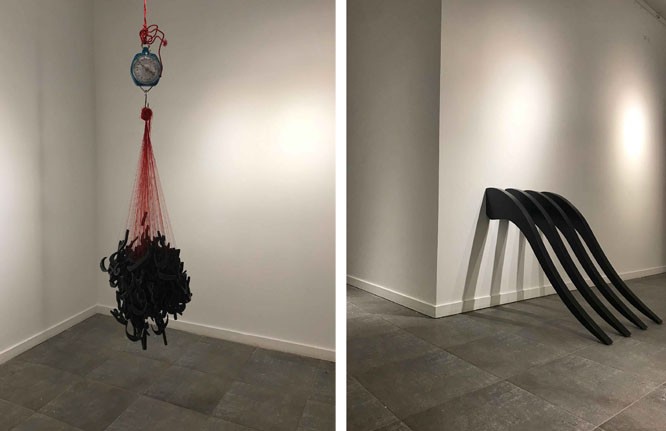
In his most important and successful show at Rohtas 2, Lahore, Muzzumil Ruheel seems to have found his voice

A literature student knows how difficult it is to translate poetry. Umberto Eco calls it "an art where thought is determined by words". You can transfer content from one language to another, but it’s hard to retain the sound attached to verse -- an indispensable feature of poetry.
Like poets, some image-makers also concentrate on language, especially on how letters are formed and placed. In most cases, the shape of writing is intertwined with the significance of script. So, the calligraphy of Quranic text has to be superb and exquisite; royal decree from a Chinese court must be elegant; and the choice of font, size and style of lettering are crucial in a work by Barbara Kruger or Jenney Holzer.
After years of stumbling in the labyrinth of language, Muzzumil Ruheel seems to have finally found his voice. He has substantial background of calligraphy; studied its traditional methods, worked as a commercial painter making posters, banners, and flyers before he joined Naqsh School of Art; and later acquired BFA from Beaconhouse National University Lahore.
His previous pieces, shown at different galleries and art fairs, dealt with script: letters juggled around, joined together and overlapped. In most of his work, meaning was not required since text was treated as texture. His works at the Canvas Gallery’s booth during Art Dubai 2018 somehow resembled Waqas Khan’s, though with a slight difference: While Khan invokes a pictorial sensation with his marks, Ruheel’s surfaces, despite being pleasant and drawing admiration, couldn’t convince of their independence as a personal expression.
That independence or maturity is essential to ensure the worth of an object in the realm of art. Being aware of his previous works in multiple genres, one realises the artist has now returned home. Ruheel comes from Lahore. So his solo exhibition ‘Point of No Return’ at Rohtas 2 (from Oct 5-27, 2018), offers a glimpse of the artist’s sojourn to a final destiny, which one hopes does prove a point of no return for him as an artist.
Past often poses a problem for artists who are incorporating historical visual; it is not easy to get rid of, is always resurfacing, stirring a sense of unease. Actually, it is difficult to determine at what stage the past, or calligraphy, turned into a convenient mode of mark-making for Ruheel. It was felt that he wanted to come out of that comfort zone but probably didn’t know how to. Meanwhile, he enjoyed considerable success. Later, he did add photographic references, geometry, chromatic contrasts, in order to put aside the ‘safe and secure’ closet of calligraphy, but none paid off. But, contrary to all expectations, he has produced something that wiped away his past -- also of calligraphy.
In the present exhibition one feels that letters in the hand of the artist are like sounds -- an infant’s attempts in grasping that ‘multiverse’ we call language. One unit combines numerous possibilities, contains and conveys everything within and beyond us. Executed in wood and painted in acrylic, Ruheel rips letters from their literal links, and treats language as a tool to entice a person a reader or a viewer.
Muzzumil Ruheel in his work has focused on that ‘formal subtlety’ of language. He has transformed one of the most common terms in our midst ‘mein’ (I), into a piece of purely poetic sculpture (‘Ostentatious Presence’), placed upside down, like his signature style ink on wasli paper, ‘Drivel’, which, mimicking Georg Baselitz, is displayed bottom up.
The vulnerability of language is visible in ‘Looking for the Weight of the Words’ too, as letters are hung with red threads to a weighing scale from the ceiling of the gallery. The work indicates that words in our mouths, ears, media and print are merely combinations; not absolute or eternal but arbitrary. According to the artist, his present body of work is "about a poet who is unable to write anything", so his works, "reflections of his struggle", become a cartography of a society in which words are available, accessible, approachable, and yet oppressive. Letters of Urdu, deprived of their meanings, are constructed as items of abstract nature, reverting to abstraction of language which transforms/translates tangible into ideas.
This is also evident in ‘Endless Rambling’ with intertwined text, written in khatt-e-musalal style. Here, line is merely memory of a conversation instead of a message. Still one believes in the presence of words, due to precision in its fabrication and installation.
It seems that Ruheel has recognised the importance of perfection -- not of physical execution but the sophistication of idea. His other works also testify how the artist is deliberately drifting from his contented and uncontested ground, and opening up new ways of saying something that cannot be uttered completely. Shapes of a few letters composed to convey Urdu word zor (‘Push’), horizontally extended on the floor make the language mute, but not meaningless. The viewer is able to discern beauty in their physicality, often overlooked due to pressure and primacy of sounds, notwithstanding the content.
This element is observed in another work consisting of four identical wooden forms attached to a wall. Almost looking like table legs, these refer to Urdu poem’s format of ending every verse with words of rhythmic sound. Intriguingly, Muzzumil Ruheel has named this work ‘Mindless Rhythm’. This is a surprising declaration; because in the field of art and literature, no formal structure is devoid of reason or relevance.
The present exhibition of Ruheel brings forth two sides and contradictions. In his most important and successful show, he seems to be opting for an elementary and simple layer of language. Yet, he prefers titles as pompous as ‘Ostentatious Presence’ and ‘Drivel’, confirming what he wrote in his statement, "Are words heavier than thoughts?"